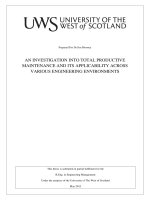Total Productive maintenance (TPM)
Bạn đang xem bản rút gọn của tài liệu. Xem và tải ngay bản đầy đủ của tài liệu tại đây (2.09 MB, 46 trang )
•
•
•
•
Laura Dietrich: Maintenance Manger
Antoinette Lockett: Plant Manger
Waseem Manzoor: Quality Manger
Xiaoyan Liu: Production Manger
Meeting Agenda
I.
II.
Understanding Downtime -Group
Major Losses of TPM -Antoinette Lockett
I.
II.
III.
IV.
III.
Planned Downtime Losses -Xiaoyan Liu
Unplanned Downtime Losses -Laura Dietrich
Reduce Speed LossesPoor Quality Losses -Waseem Manzoor
Total Productive Maintenance
I.
II.
III.
IV.
V.
VI.
What is TPM -Antoinette Lockett
Breakdown of TPM -Laura Dietrich
TPM History -Laura Dietrich
TPM Evolution
Goal of TPM -Antoinette Lockett
Three Principles of Prevention
Meeting Agenda Cont.
I.
II.
TPM-8 Pillars-Laura Dietrich
Kick off TPM
I.
Launching TPM- Preparatory Stage-Antoinette Lockett
II.
Autonomous Maintenance- Xiaoyan Liu
III. Equipment Management Life Cycle- Xiaoyan Liu
IV.
TPM Implementation-Waseem Manzoor
V.
Launching TPM- Stabilization-Waseen Manzoor
VI.
Eliminating Equipment Losses-Laura Dietrich
VII. Improvement Goals for Chronic Losses-Laura Dietrich
III.
Overall Equipment Efficiency
IV.
I.
What is OEE-Xiaoyan Liu
II.
III.
OEE Factors-Xiayon Liu
Calculating OEE-Waseem Manzoor
TPM Benefits-Xiaoyan Liu
Understanding
Downtime
MAJOR LOSSES
Planned Downtime losses
•
•
•
•
Start-ups
shift changes
coffee and lunch breaks
planned maintenance shutdowns
Unplanned Downtime Losses
• Equipment breakdown
• Changeovers
• Lack of material
Reduced Speed Losses
• Idling and minor stoppages
• Slow-downs
Poor Quality Losses
• Process non-conformities
• Scrap
TPM
What is Total Productive
Maintenance?
• TPM is a plant improvement
methodology which enables continuous
and rapid improvement of the
manufacturing process through use of
employee involvement, employee
empowerment, and closed-loop
measurement of results
Breakdown of TPM
• TOTAL = All encompassing by
maintenance and production
individuals working together
• PRODUCTIVE = Production goods and
services that meet or exceed
customers’ expectations
• MAINTENANCE = Keeping equipment
and plant in as good as or better than
the original conditions at all times
TPM - History
• Productive maintenance (PM) originated in
the U.S. in late 1940’s & early 1950’s
• Japanese companies modified and enhanced
it to fit the Japanese industrial
environment
• The first use the term TPM was in 1961 by
Nippondenso, a Japanese auto components
manufacturer
• Seiichi Nakajima – head of JIPM, one of
the earliest proponents, known as the
Father of TPM
TPM - Evolution
•
•
•
•
Breakdown maintenance
Preventive maintenance (PM)
Productive maintenance
Total productive maintenance
Goals of TPM
1. Aims at getting the most effective use of
equipment
2. Builds a comprehensive PM system
3. Brings together people from all departments
concerned with equipment
4. Requires the support and cooperation of
everyone from top managers down
5. Promotes and implements PM activities based
on autonomous small group activities.
6. Maintaining Equipment for life
7. Encouraging input from all employees
8. Using teams for continuous improvement
Three Principles of Prevention
• Maintenance of normal conditions
• Early discovery of abnormalities
• Prompt response
TPM 8 PILLARS
5s
Safety, health and
Environment
Office TPM
Training
Quality Maintenance
Planned Maintenance
Kobetsu Kaizen
Autonomous Maintenance
PILLARS OF TPM
Kick off TPM
Launching TPM- Preparatory Stage
• Announce top management’s decision
to introduce TPM
• Launch an educational campaign to
introduce TPM
• Create an organizational structure to
promote TPM
• Establish basic policies
• Form a master plan for implementing
TPM









